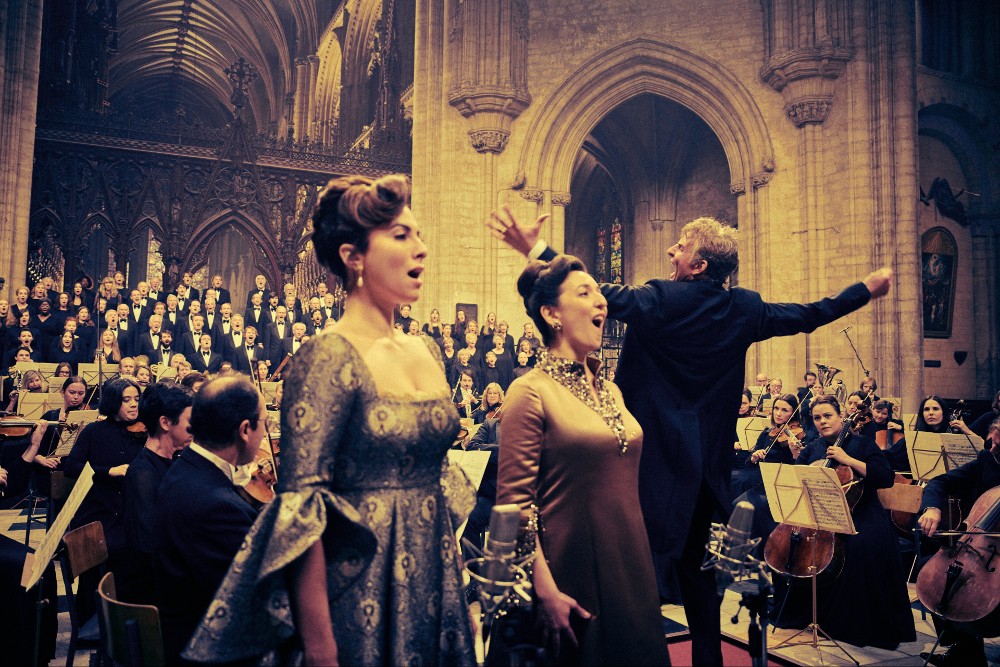
Bradley Cooper’s Maestro is quite a tour de force in the way it tells the story of Leonard Bernstein with Cooper writing, producing, directing and starring as the legendary conductor. After the success of Cooper’s A Star is Born and the eight Oscar nominations it received, Cooper probably could get anyone he wanted for his heads of department.
To design his second feature, Cooper called upon Production Designer Kevin Thompson, who won the Art Directors Guild Award for designing Alejandro G. Iñárritu’s Best Picture-winning Birdman or (The Unexpected Virtue of Ignorance) roughly ten years ago. Thompson was also nominated by the ADG for designing Tony Gilroy’s Michael Clayton and James Gray’s Ad Astra.
Thompson’s work actually goes back thirty years with credits on some of the classic indie films of the ‘90s, before becoming the go-to designer for the likes of Gilroy, Judd Apatow, and more filmmakers. Below the Line got on Zoom with Thompson to talk about what was involved with making Maestro as if they were shooting the movie at many of the real locations in Bernstein’s life… because, in fact, they were.
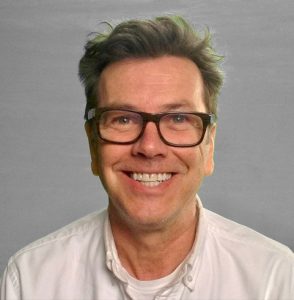
Below the Line: I was just looking over your filmography, and it’s pretty amazing. You go back to some of the great indies of ’90s and 2000s and lots of cool movies.
Kevin Thompson: I used to be an architect for 10 years, and then I got interested in the business, because I’ve always loved movies. I’m a kid from Minnesota, and I met some people on Working Girl, when Mike Nichols was directing that in one of the houses that I restored. I got the idea, “God, maybe I’d like to work in the movie business,” so I gave it a shot. Luckily, I had a couple of little indie things that struck gold early on, so it got me off on a footing. I got a late start in the business; I didn’t start till I was 38.
BTL: Wow. That’s around when I started writing about movies, about the same age.
Thompson: At that point in your life, you should know what it is that you’re passionate about and what you love.
BTL: Totally. Your credits are almost exclusively as a production designer. Other production designers often come from elsewhere in the art department or set decoration, but you jumped right into production design.
Thompson: I had a unique in, and I had a skill through my architecture and my education in art history and architectural history, that I could manage projects. I came in from a slightly different angle – no film school.
BTL: How long ago were you approached by Bradley Cooper to design this show, and how did he approach you?
Thompson: I think it was 2020 or 2019, because we shut down for a year because we couldn’t record live once COVID struck. The whole thing I feel like it was about three years with one year down. We did a lot of early pre-production. I interviewed with Bradley via Zoom. We hit it off, we had great chemistry, we both had a similar take on not doing a biopic, but doing a love story, getting intimate with the characters, feeling the authenticity of what their life was about, going deep in the research. He mentioned to me that didn’t really want to build sets, because he felt that they might not be able to feel as authentic, as if we went to locations.
He brought up the movie Birth — it was a Jonathan Glazer movie — and how this apartment that Nicole Kidman and Lauren Bacall lived in on the Upper East Side, how it felt. I said, “Well, that’s a built apartment, and it feels real, and feels kind of errorless,” and he says, “Is it?” and I said, “Yes, I know, because I designed that movie.” And he liked that, and I think that really tipped it over the edge for him to choose me to work with him. He lives five minutes from my house in Manhattan, so we could spend a lot of face-to-face time during pre-production.
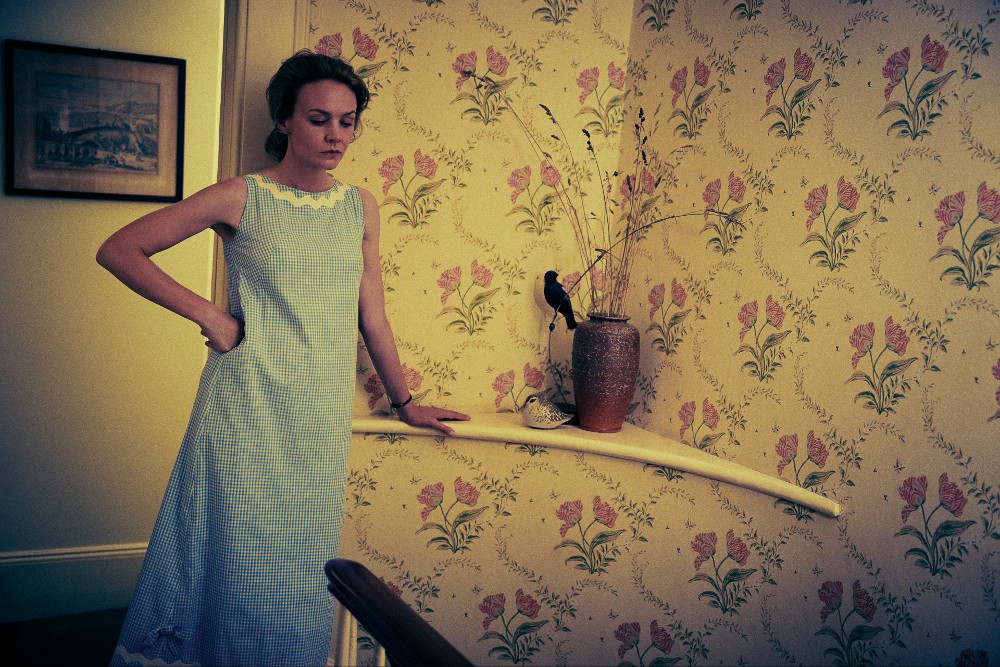
BTL: You also designed Birdman. I was shocked to learn you weren’t nominated for an Oscar for that design, but there is some DNA between that and the amazing opening shot in Maestro where we follow Lenny down to Carnegie Hall in a single shot. Did that involve building, or was some of that at the actual Carnegie Hall?
Thompson: That REALLY involved building. That was one of the early shots that Bradley described to me in detail, pretty much the way it turned out, after going through a lot of design process and a lot of reincarnations. Because of the arm of the camera and the movement of the camera, we had to put that on a stage.
The inspiration for that apartment came from the actual musicians’ studios above Carnegie Hall. We did a lot of pre-vising and a lot of virtual computer models to design that just right, so that we could take this camera lens through the way we wanted to. We tweaked it a lot, it went through a lot of evolutions, we went through a lot of rehearsals with that shot.
Similar to Birdman, we kept making the hallway a little longer. In the end, I think we did four takes, or something like that, and, and we got it, and everybody was elated. But then, about three weeks later, we reshot it, because he wanted to do one little thing differently, so we put it all back together and shot it again.
BTL: Is it easy enough to do that – once you break a set down, you can put it back together?
Thompson: Yeah, we can reconstruct. I mean, we save everything. The things that were built were the Carnegie Hall apartment, the Dakota apartment, the Osborne apartment, the doctor’s office lobby, and the Watergate Hotel Room, which is after the Kennedy Center, when she puts the slippers outside the door.
BTL: Carnegie Hall and Lincoln Center allowed you to either take pictures or shoot there, or do some part of it in the actual locations?
Thompson: We had pretty much full access to Carnegie, because we had to set up that Spidercam rig that comes down in the opening shot. The camera comes from him in the box, all the way down to the podium, and then it goes back up. We had to do two days of rigging on the stage and then set it up in period orchestra fashion for his introduction to the conducting world that happened there in 1943.
BTL: I’m a big fan of DP Matty Libatique. How do you work with him for a shot like the one you just mentioned?
Thompson: I have to say that Bradley was the glue that brought every department really close together. Matty and I [had] next to our offices during pre-production, so we would sit and look at previses, we tried different lenses and stuff. Bradley was always present. He had a vision and his hands on every aspect, and then he brought all the departments heads together, so we would all be working on the same… I think you can tell by watching the movie that every department was really linked together.
We really tried to make each decade lyrically move from one timeframe to another, and change in tone a little bit. Matty would do camera tests for the black and white footage, because everything was shot on film. All those decisions were made beforehand; it wasn’t digital where you can just take the color out. Matty would do film stock tests for our department and the costume department, so we could see how the colors reacted to the black and white film.
On some film stocks, the mid-tones would all look the same. In some cases, certain colors turned to black, so we knew what colors to avoid and also where we should add texture and where we wanted higher contrast things like that. Matty was really involved in pre-production every day.
BTL: You also mentioned using computers in the design process, which is becoming more and more common. I spoke with the designer for The Batman, and he was saying that they were even testing out set decoration by putting scans of chairs and other furniture into a computer environment to see how they would look. You can do so much in advance now even before building a thing.
Thompson: One of my most valuable tools during pre-production is my concept artists and also previs artists. I can give them a sketch, and we’ll take it to the art director — the art director will do the plans, and then he’ll put it into the 3D model, and then we’ll look at it and change the design by looking at it from different angles. We did a lot of that. He’s so advanced, you can put certain cameras and certain lenses into the frames. Matty was also using him as a tool, and it’s a time-saving device to have somebody like that, right there with you in the office, instead of working virtually.
BTL: There are visual effects involved with every movie, no matter how much you want to do it on-set and in-camera. Are you able to use some of the stuff you do in pre-production and send it over to visual effects so they can incorporate it into their work?
Thompson: Oh, yeah. Like, “We want this to look like this, or we want to erase these air events in Carnegie Hall.” We want to test out furniture. We want to make a presentation of set dressing in a room, so that we can show Bradley what we have in mind before we actually do that. It’s very useful for many departments.
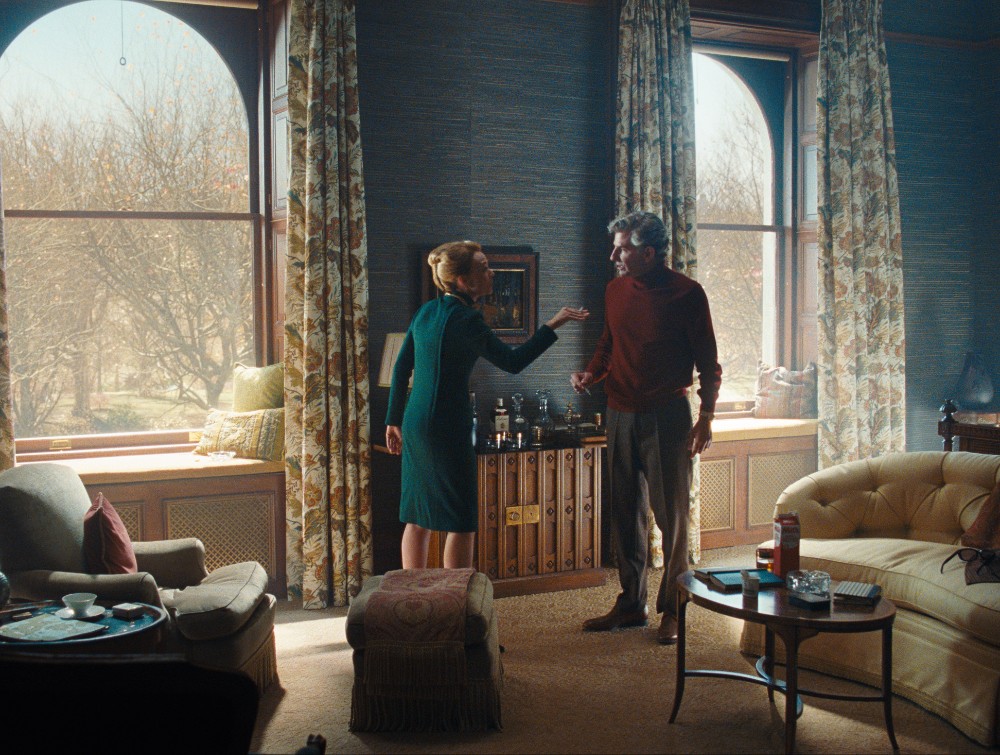
BTL: One of the locations I really liked was the Bernstein house, which we see in the latter part of the film. Does that house still exist? I know his daughter Jaime was one of the producers, so did she give you access to use it or take pictures there?
Thompson: The three kids, particularly Jamie and Alexander, use the house on the weekend and in the summertime. They granted us not only access to shoot there, but also all the tiny, valuable references that were in the house — the family photos, Felicia’s paintings on the walls, which wallpaper was there when they were raising their family there. What the drapes look like. A lot of the original furniture was there.
I just needed to be freshened, so it was valuable to be there and shoot there, because you could spiritually feel the ghosts of Lenny and Felicia living there. They had separate bedrooms upstairs, and they were basically unchanged. You could really smell them there.
We did recreate his studio from scratch out in the cottage by the barn where he wrote music, but the piano in the living room, which is still there today, is the piano he had given to him by his music teacher. It’s barely moved, just a little bit across the room, since he lived there. It was valuable for the emotional core of things to feel the nuances of who those characters were.
BTL: That piano that Bradley is playing at the beginning of the movie, that’s Bernstein’s actual piano? [Thompson nods to confirm] I could really feel the authenticity of things like that and Carnegie Hall.
Thompson: I think we were all feeling it when we were there, the authenticity. It adds an intimacy for the audience to understand that, as a designer, understand the emotional core of things. That was something he stressed from the beginning, authenticity and intimacy.
BTL: One of the other key scenes was him conducting the opera, which I think was in Vienna?
Thompson: The Mahler piece at Ely Cathedral, which is one of the largest Catholic cathedrals in Europe. It’s about two hours north of London. It’s a beautiful little town with a little Main Street with beautiful countryside. Can you imagine the people that moved into that town for that week? Not only the London Symphony Orchestra and the London Symphony Choir and 250 extras, but the entire camera crew art department. It was fantastic to actually be there and recreate that.
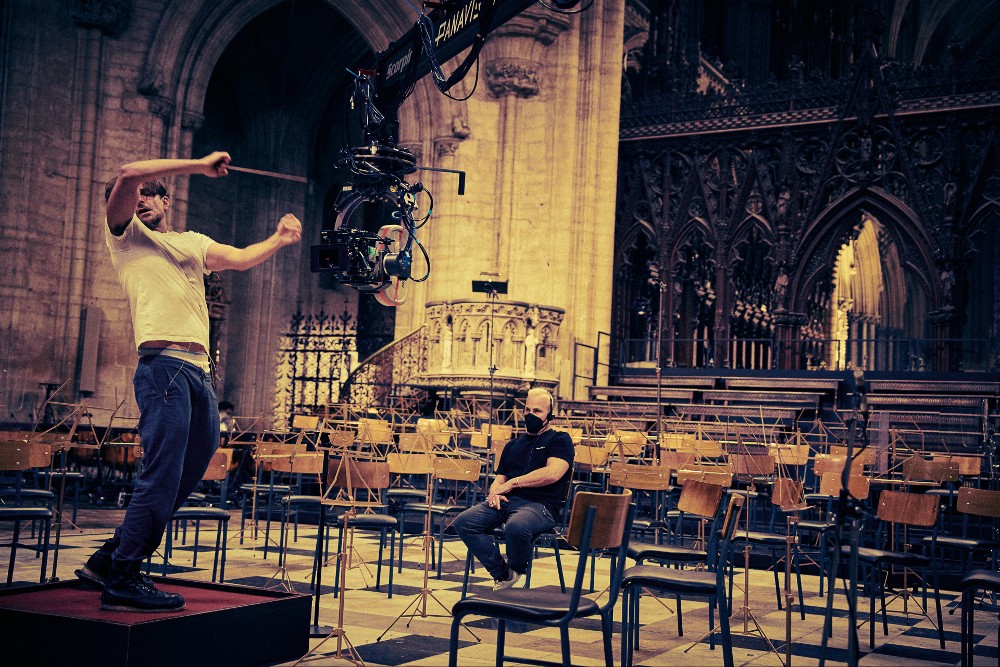
BTL: How long were you there shooting it?
Thompson: We were there for a week, rehearsing, prepping and shooting. We actually only shot two full days, but we rehearsed one full day with the orchestras and the choir. We had to do all the rigging. We had a Spidercam up in the loft and coming all the way down to the first floor. We had to build risers and get period chairs and music stands and pews and strip out all the contemporary elements in the church and the town. I think we donated a lot of stuff to that town. [laughs]
BTL: Do you generally work with the same set decorator and art director from project to project, or do you at least try to?
Thompson: I have favorite people in New York, but I do look at the specific project and the uniqueness of what the project has, and then sort of go from there. I’m starting a job in Boston, or I started over the summer, but it’s starting back up again today, and I’m using a team from an LA and a lot of local people in Boston. It’s exciting to work with different people, but I do have favorites in New York.
BTL: Do you generally feel comfortable going to places like Boston and England, if you have a few people from the area to work with?
Thompson: I’m at an age where my choices in movies are usually director-driven projects, so I never think of it as “jobs.” But if I connect with a project, then I will travel. This one in Boston, I’m really close with… it’s the same director, James Gray, that I’ve done three movies.
BTL: I noticed that you had a role in Maestro, and you have also had acting roles in other movies you’ve designed. Is this another late in life career change?
Thompson: No, no. In all cases, I’ll tell you the whole story in one sentence. In each case, the director at the last minute says, “I want you to do this.” And I’m like, “I don’t really like doing that. But if you really want me to, I will.” That was Judd Apatow on Trainwreck, the day before. I did a scene with Amy Schumer, playing the Vanity Fair editor.
In Sharper, Julianne Moore and Ben wanted me to be in the lunch scene with her, so that she could feel comfortable with who she was whispering in the ear of. And then in Maestro, Bradley, he enjoys putting people in a little bit here and there. It was the last day of shooting in that funny little TV program that Felicia was doing, and he said, “You be the director. I’m gonna write you a line.” [laughs] But it’s not something I plan on pursuing.
BTL: I actually visited the set of Trainwreck in Queens, but like I said, I’m a fan of many of the movies on your filmography, that I’m now gonna have to rewatch and focus on your design work.
Thompson: I definitely have favorites. I think Michael Clayton is a beautiful movie, and I think Stranger Than Fiction is really fun. People say, “What’s your favorite movie?” and I always say, “Whatever I’m working on now, honey.”
Maestro is now streaming on Netflix.





